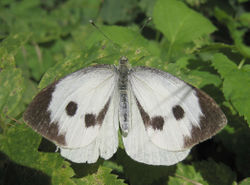Pieris brassicae
| Literature database |
|---|
| 189 articles sorted by: |
| • year (descending) |
| • research topics |
| • countries/regions |
| • host plants |
| • list of natural enemies |
Pieris brassicae (Linnaeus) - (large cabbage white)
The butterfly is a serious pest of cabbage in Europe and western Asia, specially during the 2nd generation. It has been introduced into several countries outside its native range. These include Chile (first record 1972), South Africa (first record 1994) and New Zealand (first record 2010). It attacks mainly Brassica species, but might also damage various other crucifers. The damage is usually localized but can reach almost complete crop losses.
Batches of yellowish eggs are laid on the underside of the leaves. The larvae are gregarious and on cabbage they attack the open leaves first before boring into the head. Development from eggs, through 5 larval instars to mature adult lasts around 1-2 months. There are up to 4 generations per year under favourable conditions. Pupae go into diapause during the winter. The adults a good flier and can migrate in swarms.
| Vernacular names | |
|---|---|
| • Deutsch: | Grosser Kohlweissling |
| • English: | large cabbage white cabbage butterfly |
| • Español: | mariposa de la col |
| • Français: | piéride du chou |
Insecticides are often used for control. However, natural enemies like Cotesia glomerata are important and need to be preserved. Therefore biological pesticides like Bacillus thuringiensis preparations should be preferred.
Adults have a wingspan of around 6 cm. The colour is white with the forewings having 2 black spots in females and dark tips. The mature larvae are 4-5 cm long, greenish to yellowish with black marks and spots.
- Other images of Pieris brassicae (Wikimedia Commons and IPM Images - click to enlarge)





